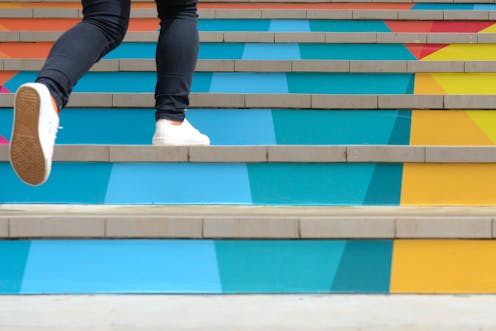The top ranking education systems in the world aren't there by accident. Here's how Australia can climb up
- Written by Julie Sonnemann, Fellow, Grattan Institute

The latest OECD Programme for International Student Assessment (PISA) results show a long-term decline in reading, maths and science skills for Australian students.
In 2018, Australian 15 years olds performed more than a year below those in 2003 in maths, about a year lower in reading than those in 2000 and a year worse in science than those in 2006.
PISA doesn’t test rote learning but how well 15-year-old students can problem solve and apply their knowledge and skills to real world situations.
PISA also shows which countries are the highest performers and which are getting better in science, maths and reading. Singapore has been the highest scoring country in all areas since it joined testing in 2009.
The latest results show Australian students were three years behind Singapore in maths and three months behind in reading.
Read more: Aussie students are a year behind students 10 years ago in science, maths and reading
The Beijing, Shanghai, Jiangsu and Zhejiang economic region (the participating regions of China) were three and a half years ahead of Australia in maths in 2018. Hong Kong performed at the same level as Australia in reading in 2000, but outperformed Australia in 2018.
High performing systems invest relentlessly in their teachers. They focus on the same things Australian governments do – recruiting the best, training teachers well and giving them practical support and development.
But our 2012 study of four high performing East Asian systems – Hong Kong, Korea, Shanghai (the region of China that participated in PISA before 2015) and Singapore – showed they followed a much more intensive process of seeing these changes all the way through into the classroom.
Hong Kong made big reforms to reading in five years
Hong Kong performed at the same level as Australia in reading in 2000. But between 2001 and 2006, it used a series of deliberate reforms to go up from 17th to second place in the OECD’s Program of International Reading Literacy (PIRLS) test.
First, they re-examined their teaching approaches, more specifically how to best teach reading. Researchers from the University of Hong Kong developed a new approach to teach reading Chinese, based on an extensive review of learning theories.
Read more: Three schools reforms that will lift student outcomes
Called the “integrative perceptual approach”, the teaching strategy moves away from memorising single Chinese characters to integrating the way students perceive the meaning and structure of Chinese in reading, writing and using language.
They then made an intensive effort to help teachers shift practice.
This included:
researchers explicitly training thousands of principals and teachers in the new teaching techniques
schools and teachers being supported to adopt the new approach through seminars, new teaching materials, sample lesson plans, as well as on-the-job support from curriculum experts and research academics
teachers having good access to peer support through classroom observation and teacher networks
parents being engaged to create a good home reading environment.
This is not a case of improvement through government control. Hong Kong provides a high level of school autonomy similar to Australia. But systematic government policies made it easy for schools and teachers to improve how they taught reading, resulting in large shifts in teaching practice.
Singapore focused on teacher quality
Since Singapore gained independence in 1965, it has transformed from a poverty-stricken country to one of Asia’s great success stories. Its schools are among the best-performing in the world.
This is a result of intentional government policies that treat its teachers as professional partners.
Singapore invests heavily in recruiting bright people to teaching. The selection process is tough, with only one in ten applicants selected, but their key to success is encouraging many young people to apply.
For example, the Ministry of Education pays student teachers a generous stipend during their initial teacher training – an approach we recommended in our latest report as one of best ways to attract more bright young people to teaching in Australia.
Read more: What are the main challenges facing teacher education in Australia?
Singapore also reformed its teacher pay and career structures in 2000 to help make it a more attractive career choice. It raised teachers’ pay for new positions (equivalent to vice-principal pay and above), created a new system of teacher performance management, and tied it to teacher development and professional learning.
Singapore also introduced elite “master teacher” positions. A teacher can reach such a status based on outstanding performance in their subject field. Master teachers became the teaching leaders in their subjects, helping set directions and connect schools to the best research.
Master teachers also mentor senior teachers in schools, who in turn help other teachers improve through regular classroom observations, research groups, professional learning communities and mentoring.
What Australia can do
Hong Kong, Singapore and other high performing systems did not stumble into PISA success by chance. They did it by design. We can do it too.
Teachers have the biggest impact on student learning outside of family and home influences. Looking at Hong Kong and Singapore, we can improve teaching effectiveness by better attracting high achievers to teaching and providing better career and development support.
We must start by getting a much better understanding of the problem. This means re-examining how we teach maths, science and reading. This is fundamental to getting the right teaching supports in place, so improving practice is easy to do, not harder.
For Australia to improve, it is not about radically changing policy directions, or doing one thing differently. Instead, Australia must do many things better; much, much better. We must do them more systematically and with more intensity.
The devil is in the detail, and in implementation.
Grattan Institute’s forthcoming report in early 2020 will examine what Australia can do to improve teaching through better workforce structures.
Authors: Julie Sonnemann, Fellow, Grattan Institute





